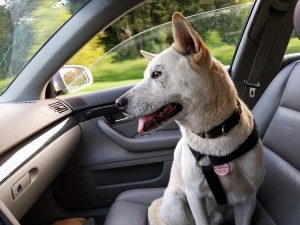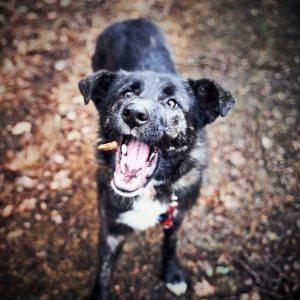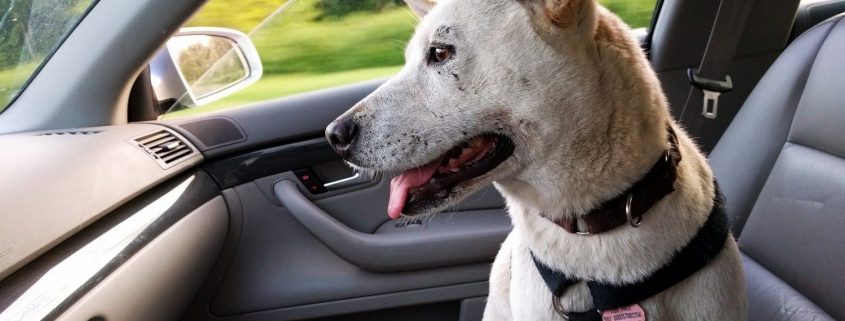Ask Crystal: Road Trip Ready Dog
Welcome to “Ask Crystal,” where you can ask your pet behavior questions! You can submit your question for Crystal at the bottom of the page!

Dear Crystal,
With the summer here, I really want to take a road trip with my dog. He throws up and shakes in the car when we take him to the vet so I am not sure what we can do about it. Is there some training or something we can do to help him feel better about car rides so he can actually enjoy himself?
Sincerely,
Road tripping
Dear Road,
There are different reasons why a dog might get car sick. It might be motion sickness or it might be travel anxiety. It can be difficult to tell the difference between motion sickness and car anxiety. Some signs of motion sickness are: drooling, panting, pacing, whining, swallowing, lip licking, hunched posture, tight face, wide eyes and vomiting. These signs can also occur with travel anxiety which is one of the reasons it is so hard to know which it is.
If your dog is a puppy, he is more likely to get nauseous in the car. This may be due to the fact that the part of the inner ear that controls balance is not fully developed yet. If that is the case, it might get better with age as he grows. Dogs probably get car sick for the same reasons that humans do. Sometimes feeling car sick can make a dog become anxious about car rides which is not something they will outgrow and may become worse.
Start by talking to your vet. It is important to rule out an underlying medical cause which could be causing the symptoms. If no medical concerns are found, your vet can talk to you about medications and supplements which can ease the symptoms of motion sickness. If the dog’s symptoms are caused primarily by motion sickness, the medications should ease most of their symptoms and you should see improvement. If it does not, then you likely have some underlying travel anxiety as well.
It can be important to isolate the cause of the anxiety in order to improve the situation. If the only place you ever take your dog in the car is to the vet, he may not have a good association with the car if he doesn’t like the vet. My own dog’s car anxiety was due to his fear of the cars outside of the window. We have been working on his car fear outside of riding in the car and he has gotten so much better riding in the car since. If the dog experiences pain jumping in the car because of arthritis or some other painful medical condition, that would need to be addressed as well.
Management for this type of issue is first avoiding the car rides as much as possible. We don’t want to push the dog over threshold so unless it is an emergency, we need to avoid car rides. Consider a mobile vet or groomer so the dog can stay home for those important visits. If your only option for walks is a drive to the park, find ways at home to exercise your dog instead. Walks are not critical at this stage and they will likely do more harm than good. We also need to locate any additional stressors in the dog’s life and work on easing as much of his stress as possible so that is not compounding his reaction.
If you are able to determine the cause of the anxiety, you would need to create a plan to work on the dog’s emotions surrounding those events. I highly suggest that you make an appointment with a Certified Professional Dog Trainer https://www.ccpdt.org/dog-owners/certified-dog-trainer-directory/ It can be really difficult to decipher the cause of the anxiety by yourself. Creating a training plan is a lot more complicated than it sounds and it really helps to have someone watching and troubleshooting. Many trainers offer day training so that they do the bulk of the training for you which makes it so much easier for you.
For fear related behaviors, trainers use a desensitization and counter conditioning protocol. Desensitizing means that we expose the dog to the fear inducing stimulus at a level which does not induce the fear response. That means figuring out exactly where it is that your dog begins to pick up on the cues that a car ride is imminent. Being able to accurately read dog body language is critical to pick up on the signals that the dog’s stress is ramping up because we have to work with them before that point. Is it when you pick up their leash or walk towards the leash? It may be helpful to create a list of everything you do before you take him for a ride and make notes of his behavior at each point.
 Counter conditioning means that we pair the presence of the fear inducing stimuli with something inherently reinforcing to the dog like high value food treats or play. If grabbing the leash provokes the response, we might start by walking a distance from the leash and tossing yummy treats to the dog. We would slowly work our way to the leash and then start touching it and picking it up. At every point we are looking for a happy response before moving on to the next step.
Counter conditioning means that we pair the presence of the fear inducing stimuli with something inherently reinforcing to the dog like high value food treats or play. If grabbing the leash provokes the response, we might start by walking a distance from the leash and tossing yummy treats to the dog. We would slowly work our way to the leash and then start touching it and picking it up. At every point we are looking for a happy response before moving on to the next step.
The process for changing a dog’s emotions regarding car rides can be long so it’s important to be patient and try not to push ahead too fast. A sample protocol might look like this: You might start by walking the dog by the car without walking directly up to it and treating. You may then start to pause briefly and treat at the car. Next, we might open the car door and work on the dog approaching the car with the door open. Then work on the dog approaching the open door by treating any approach. Next you might feed meals in the open door. Once you get the dog to go in the car willingly, feed meals in the car with the door open. Close the door while the dog eats for the next step.
Then you need to work on your presence in the driver’s seat while treating the dog. We then need to acclimate the dog to the ignition turning on. Then once the dog is comfortable with the engine on, increase the amount of time the engine is on. Then we would drive backwards slowly and go forward. All the while we need to be feeding high value treats. Then you can begin to increase the distance you drive at whatever pace the dog is able to. It is really helpful to have a companion to treat the dog when you are actually driving the car. It is much safer to be able to concentrate on driving. You might also be able to use a remote treat dispenser like the Manners Minder. I would still have a helper pressing the remote if you are actually driving the car.
Hopefully, your dog’s issues are mostly car sickness and medication can help address them. I would suggest that until you know exactly if the cause is motion sickness, you not plan any trips with him at the moment. It isn’t going to be fun for either of you if he is anxious and it will likely make the behavior worse until you have had a chance to work on it. It can take several months and some dogs can only tolerate the car rides and never learn to love them. Hopefully, you are addressing this issue soon enough so that you will be taking road trips that you both can enjoy soon enough.
Until next time,
Crystal







